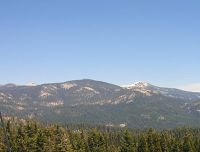UW Study: Bedrock Influences Forests More Than Previously Believed
10 Feb 2014
Bedrock influences forests and landscape evolution much more than was previously thought, according to a study by University of Wyoming scientists.
Bedrock influences forests and landscape evolution much more than was previously thought, according to a study by University of Wyoming scientists published this week in the Proceedings of the National Academy of Sciences.
When investigating factors that influence forest cover in California’s Sierra Nevada, the UW researchers determined that bedrock may be just as important as temperature and moisture in regulating the distribution of vegetation across mountain slopes.
Jesse Hahm, who recently received a master’s degree from the UW Department of Geology and Geophysics, is the lead author of the study, “Bedrock composition regulates mountain ecosystems and landscape evolution.” Other contributors are Assistant Professor Cliff Riebe, PhD candidate Claire Lukens and research scientist Sayaka Araki.
Their investigations took place at the Southern Sierra Critical Zone Observatory, one of the National Science Foundation’s ten observatories used to study the Earth's "critical zone". Critical zone research examines how water, life, rock and air interact from the base of soil to the top of the vegetation canopy.
The western Sierra Nevada is home to highly productive forests and large exposures of beautiful granitic bedrock, Hahm says.
“We were puzzled by the patchiness of vegetation on mountain slopes. There are densely forested areas right next to areas with little or no vegetation and soil,” he says. “Strikingly, these bare areas sometimes
occur side-by-side with groves of the largest trees on Earth, Giant Sequoia.”
The researchers determined that bedrock composition acts to limit plant growth, Riebe says.
“Unexpectedly, we found that differences in bedrock composition are just as important as climate,” he says. “This is hard to see without spatial analysis tools and integrated datasets on how vegetation and
bedrock vary across the landscape.”
The scientists demonstrated that differences in forest cover can be explained by variations in geochemical composition of underlying bedrock. Noting that plants get some of their nutrients from weathering of
minerals as bedrock is turned into soil, the UW researchers found that some of the granitic bedrock contains extremely low amounts of plant-essential nutrients such as phosphorus.
"These results are important because they demonstrate that bedrock geochemistry is on par with climate as a regulator of vegetation in the Sierra Nevada and likely in other granitic mountain ranges around the world,” Riebe says.
“The astonishing thing is that subtle differences in the cooling history of granite 100 million years ago can give rise to biogeochemical interactions today that produce vegetation patterns visible from outer space,” says Gordon Grant, a USDA Forest Service research hydrologist and professor in the Departments of Geosciences, Forest Engineering and Resources and Management at Oregon State University. “Understanding these subtle yet profound linkages is at the heart of critical zone science.”
The findings also show that differences in forest cover correspond with significant differences in erosion rates. The differences in forest and soil cover appear to affect the rate at which the Sierra Nevada is wearing down due to the action of water, wind and life, Hahm says. “Where soil is present, the landscape is lowering at a faster rate, suggesting that soil helps accelerate the processes that weather the underlying bedrock,” he says.
“The authors have convincingly shown that the bedrock is talking to the trees, and the resulting distribution of trees, in turn, is dictating the rate at which the landscape itself is evolving,” Grant says.
Additionally, Riebe says, the findings will augment efforts to understand how mountain forests will respond to inevitable changes in temperature and precipitation. “Most of these studies point to an upward shift in vegetation toward higher, cooler elevations,” he says.
“But changes in climate may be only part of the story as forests evolve. Our results suggest that any upward shift in vegetation will occur with the consent of the underlying bedrock.”
The work was supported by National Science Foundation grants to Riebe through the Critical Zone Observatory Program.
Riebe praises Hahm’s contributions, noting that it is rare for someone at the master’s degree level to publish as a lead author in a prestigious journal such as the PNAS.
“I had a fantastic experience doing fieldwork, and had tremendous support from the geology department at the university, including funding support from the Shlemon Center for Quaternary Studies” Hahm says. “It became a cross-disciplinary experience, integrating ideas from landscape ecology, geomorphology and petrology.”
Broader Coverage
This article was covered in the press: LiveScience, Scientific American, Laboratory Equipment, Phys.org, and others.
News Category:
RESEARCH |
PUBLICATIONS |
PEOPLE
People Involved
CZO
-
Sierra, GRAD STUDENT
-
Sierra, INVESTIGATOR
-
Sierra, GRAD STUDENT
-
Sierra, COLLABORATOR
Publications
2014
Bedrock composition regulates mountain ecosystems and landscape evolution. Hahm, W.J., Riebe, C.S., Lukens, C.E., and Araki, S. (2014): Proceedings of the National Academy of Sciences 111(9):3338-3343
Explore Further






